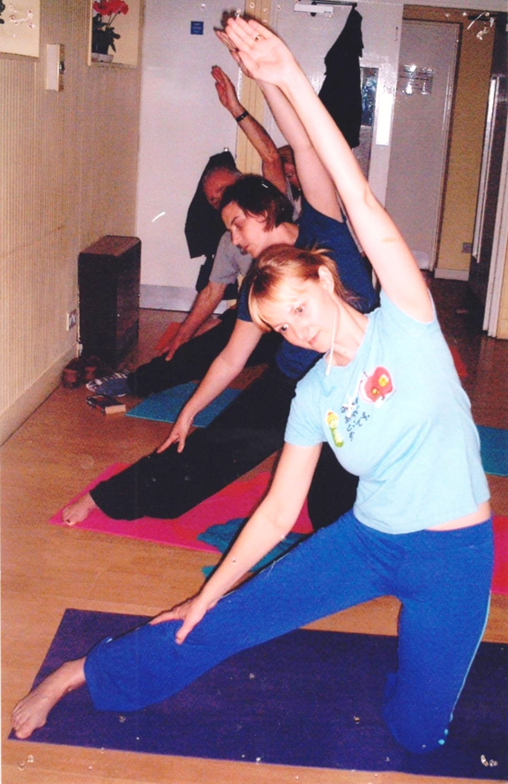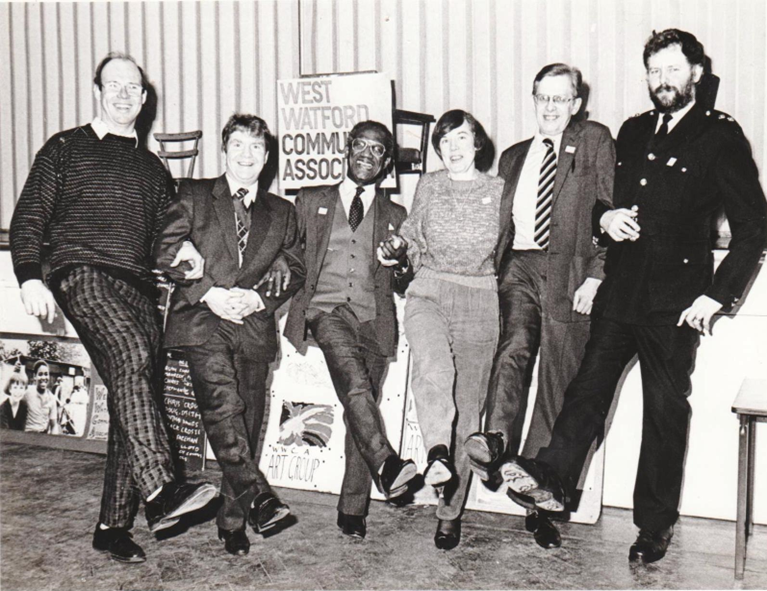West Watford History Group are delighted to include on our website some of the photographs and information made available at an Open Day held at West Watford Community Centre.
The event was held on Saturday, 7th October 2023 and attended by members of West Watford History Group, who joined the celebrations to commemorate the Centre's 50th anniversary.
Celebrations were enjoyed with the help of entertainment via a karaoke-style sing-along, a dance demonstration by our Manager and her dance partner and music provided by our Guitar Group. Something was going on all day.
Refreshments were ongoing throughout and tours of the building were accompanied by its history from 1904.
There was face painting for the kids, displays of past events and current activities. A great time was had by all.
We were delighted to see so many people enjoying these celebrations, including our willing volunteers, the various businesses and individuals who donated cakes and treats and our guests from Watford Borough Council who were so supportive.
We also had a visit from Peter Taylor, our Mayor, and Councillor Ian Stotesbury.

The history of the premises at 15 Harwoods Road and the Community Centre which has been located there since 1973 is summarised in the following document.
Extracts from our 1994/95 Annual Report have been used to illustrate how we have progressed in the 50 years since our inauguration.
(To aid recognition, these extracts have been coloured blue.)
The above information was researched by Roger Kattenhorn, who has been closely associated with our Centre for many years and with the West Watford History Group. Roger's work on this subject is much appreciated and was displayed and discussed with visitors during our open day tours of the premises.
oOo
The additional information below was discovered during West Watford History Group's search for combatants of World War I who emanated from West Watford and was included with Roger's research during our tours.
In the accommodation above the shop at No 15 Harwoods Road, their once lived a young couple whose life was altered when war was declared in 1914.
Frank Bonham Ryder was the son of John Ryder who was the proprietor of the dairy at No 15 Harwoods Road from 1912 and possibly helped his father run the business.
Frank was called to arms during World War I and did his duty, but lost his leg in battle and returned home in 1919, a disabled man.
Frank moved to Princes Avenue when he returned to England with his wife Dorothy and their two children, Dorothy and Jack. He eventually moved away from Watford, where he had practiced as an electrical engineer and was living on the Isle of Thanet at the time of his death at 76 in 1963.
It is highly likely that World War 1 had a negative effect on Frank and his family and many other families.
How many other stories are there about families living in and around Watford during the early years of the 20th century?
oOo

The West Watford Community Centre was the first multi-cultural and multi-racial establishment in the area and the groups supported by the Association, whilst now using larger premises due to their success at gaining members, still appreciate how much they gained from hiring the Centre in their formative years.
All of our own Centre-based activities remain open to everyone in our neighbourhood and where possible from other areas, regardless of race, religion, sexual orientation, age or disability.
oOo
In 1973 when West Watford Community Association was formed and took up the tenancy, the shop and accommodation at 15 Harwoods Road, with stable at the rear, was owned by a man who had a handicapped son. When the owner died his property was left in trust to his son and Watford Borough Council eventually acquired the property from the son's trustees.
The project was set up jointly by the Young Volunteers Force Foundation in Watford (established in 1969), Watford Borough Council, Herts County Council and their Department of Social
John Holt, Secretary of West Watford Community Association
Joan Mathers started the weekly Community Service Group and coped with many and various tasks. John Holt, who took over from her as Secretary, organised a much sought after gardening service for the elderly. John's attachment to Trinity Church aided him in bringing the two organisations together and many WWCA shows and events were held at the church.
Joan and John kept detailed records of activities and services by volunteers, helped with fundraising and organised steering groups to consider the needs of the residents.
The activities and services grew from these early days and between 1976 and 1995 Friendly Evenings with music and food were very popular, as were garden and street parties.
 |
| The Senior Citizen's Club in the early 1970s when they met regularly in Trinity Church Hall |
In 1983 Joan Mathers retired and Jackie Maunders took over as Co-ordinator.
At that time there were over 200 volunteers and around 150 children attending our street parties.
In 1986 an approach was made to the Council for funding to redevelop the Centre. Councillors were impressed with WWCA's excellent record of service and the work took place shortly after.
WWCA moved into temporary accommodation in Harwoods Road and used St Michaels church hall for some of the regular events.
It took a little time and a lot of hard work when WWCA moved back to 15 Harwoods Road, but eventually relationships were built up with residents and business partners and the Centre was once more in its rightful place, at the heart of West Watford.
The challenges West Watford now faces are, in the main, high utility and food costs, both affecting the Centre and local residents, an increasing number of young people suffering isolation and often poverty and lack of adequate housing.
Over the past 20 years, the population has become more diverse and there is a younger majority, many of whom are single. This group often become isolated and need help settling into new homes.
WWCA is constantly reviewing its services in order to improve them and provide the community with a place where people can meet others, learn new skills, keep fit, seek advice or comfort and generally feel at home in their own community centre.
However, we continue our programme of running daytime social/discussion meetings aimed at older people and are equipped to support our housebound residents with meetings and talks via Zoom, phone calls and email. This became a feature of our services during the COVID 19 pandemic and during lockdown and has proved very popular and successful.

In addition to street parties, there was a crèche for young children and a Summer Play Scheme for older kids who were taken to places such as the Royal Observatory in London, out and about to farms and parks and to plenty of organised activities at the centre and elsewhere.
However, our weekly Toddler Group helps many young and isolated mothers and carers of various faiths and cultures to interact with each other and learn about other such groups in the area held on different days.
Communication problems are also lessened, as the meetings provide a forum for practicing language skills.
 Whilst numbers in our fitness groups are restricted due to lack of very large hall space, we can accommodate yoga and mild exercise classes.
Whilst numbers in our fitness groups are restricted due to lack of very large hall space, we can accommodate yoga and mild exercise classes. Our larger rooms are suitable for junior dance classes and we have catered for these throughout the past 50 years.
When WWCA first opened the Centre, there was a great need for room space to be available for hire to various institutions concerned with settling residents into the area and giving children and adults extra learning facilities.
Even in 2024, there are still needs in this category and other categories such as learning basic household skills in order to help children with Maths and are open to suggestions for other classes. Our digital inclusion classes and special cooking classes are of immense help to many people and we are constantly reviewing the possibilities of learning on our premises.
Present staff, Trustees and other Volunteers appreciate the dedication of those who were involved with the Centre in earlier times and do our best to continue the tradition of serving the community in the best ways possible.
This was Arthur McLean’s final plea in 1995. We too would appreciate more volunteers coming forward to give a hand. It would make a world of difference to what we offer the community and give such immense satisfaction and joy to those who volunteer and spend time together and with members of our community.
We continue to rely on our willing band of trustees and other volunteers to involve themselves in the promotion and maintenance of our activities.
oOo
West Watford History Group hopes you have enjoyed reading this brief summary of West Watford Community Association's 50 years of activity.
If you wish to learn more about WWCA and the Centre in Harwoods Road, please do not hesitate to contact:
Centre Manager: Pavlina Kingsleigh
West Watford Community Centre (Registered Charity No 1141618, Company Limited by Guarantee Number: 7386863)
15 Harwoods Road
Watford WD18 7RB
Telephone: 01923 235488
Email address: pavlina@westwatford.org.uk
Website: www.westwatford.org.uk
There are activities to suit people of all ages and abilities when it comes to exercise. We host social gatherings, advice is available during our drop-in sessions and Digital Inclusion classes and from our office. We hold special events throughout the year and craft sales in Spring and near to the December festive season. Our events are advertised via Facebook, on the website and on notice boards throughout Watford.
We are keen to learn from our residents about any activities they believe would be suitable for setting up by the Centre or any improvements they believe should be made to those we are currently running. We look forward to hearing from you and seeing you at one of our Monday Coffee Morning meet-ups with neighbours and friends, where newcomers are always welcome.
With many thanks to Sue Ettridge, Centre Trustee and Volunteer for the wonderful history she has put together here.
oOo























